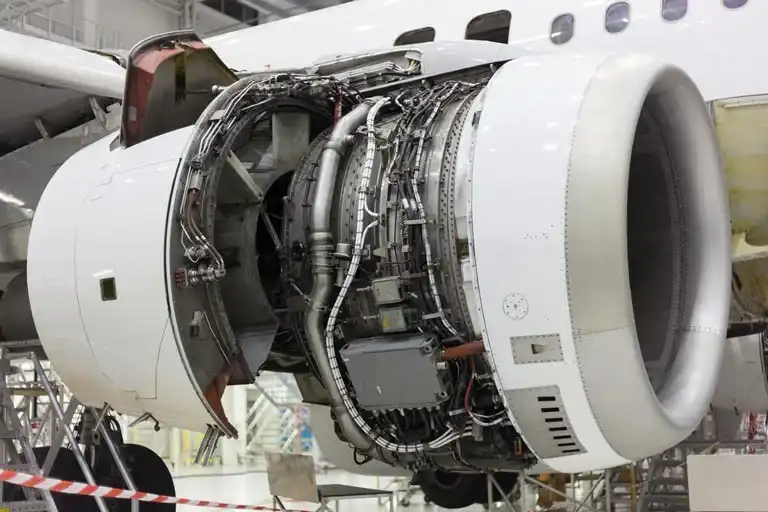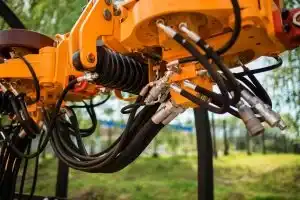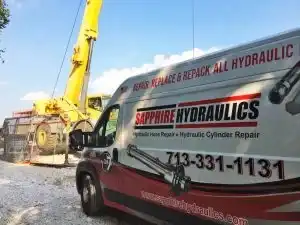 24 hour on-site hydraulic repair, replacement, hose & fitting services.
24 hour on-site hydraulic repair, replacement, hose & fitting services. 24 hour on-site hydraulic repair, replacement, hose & fitting services.
24 hour on-site hydraulic repair, replacement, hose & fitting services.

The science behind hydraulic use is using a pressurized fluid to power an engine or system. A person can generate a large amount of pressure by using a small amount of fluid in the system. Hydraulic systems push and pull back a variety of things.
Many different industries rely on hydraulic use, such as mobile, industrial, and aerospace industries. There is no other industry that is such a challenge for design engineers than the aerospace industry. Challenges come with all the constraints within this industry.
In the beginning, during WWII, a simple form of hydraulics for a few secondary control systems expanded its use as the aerospace industry became increasingly complicated to include airliners, military aircraft, and helicopters.
Hydraulic systems became more complex as aircraft became exceedingly complicated. Hydraulic systems controlled and assisted in the performance of flight control panels, flap or slat drives, nose wheel steering, land gears, thrust reversers, rudders, emergency driven electrical generators, spoilers, and cargo doors.
In the military realm, there is a mound of different types of equipment using hydraulic systems. Hydraulics make the operation such as weapons-bay doors and heat exchanges on aircraft operate to maximum potential. Hydraulics operate in extreme temperature, speed, weight, and fluid compatibility.
The aerospace industry offers hydraulic systems a higher pressure and pounds per inch or 4,000 to 5,5,000 psi. Other sectors using hydraulic systems outside the aerospace industry use only 1,500 to 2,000 psi. Engineers must design hydraulic systems in aircraft to tolerate temperatures from -65 F to at least 275 F.
The fluids used in hydraulic systems in the aerospace industry are thinner than those used in industrial. These fluids must be fireproof and remain at -65 F. There are four types of fluids used in the aerospace industry, which are as follows:
Hydraulic Pump Specifications are stricter in design, construction, and of a higher quality. The following are the differences between aerospace and other industries. Someone must maintain shoe bearing plates and plate faces due to the use of inadequate fluids:

In the last 13 years, our company has seen immense improvements in providing to industries custom hydraulic equipment and custom hydraulic systems. We see mass improvements in our engineering, design, contract manufacturing, and custom spare parts. In addition to providing services across the United States, we provide services to many global industries.
We are a family-owned company and have served many industries for over 13 years. Our expertise is in providing custom industrial hydraulic parts, equipment, and systems to the masses. There are other industries we serve besides aerospace businesses, such as seen in the following sectors. We are experts in the following sectors. Although the aerospace sector is the most massive industry, we also serve:
 Our team is well-tuned to the power of fluid in motion. Hydraulic systems do not last forever. Our expertise is the custom design and manufacture of unique parts you may need for specialized machinery. Generations, thousands of years ago, knew the power of fluid in motion. Our staff is highly skilled, knowledgeable, and experienced in hydraulics and system repairs in the aeronautical field.
Our team is well-tuned to the power of fluid in motion. Hydraulic systems do not last forever. Our expertise is the custom design and manufacture of unique parts you may need for specialized machinery. Generations, thousands of years ago, knew the power of fluid in motion. Our staff is highly skilled, knowledgeable, and experienced in hydraulics and system repairs in the aeronautical field.
There are many entities using hydraulics in the aerospace business. Our expertise is the design and manufacture of custom hydraulic equipment, parts, and systems. Because the aerospace industry is so vast, we can identify and meet numerous and specific needs and challenges that the aerospace industry presents.
he aerospace industry demands highly innovative solutions and a vast and complex set of challenges that our team meets with technical knowledge and industry expertise. Our expertise is custom designing parts such as cylinders and complete hydraulic systems for the aerospace industry.
The aerospace industry demands systems to meet dangerous terrains, heavy loads, harsh environments, and extreme applications. Our hydraulic systems last longer and report less breakdown. The aerospace industry is vast, powerful, and one of the largest industries in the world. The businesses that commonly use hydraulic systems are Military aircraft, missiles, spacecraft, commercial airliners, and general aviation.
The aerospace industry supplies hydraulic systems and parts for hydraulic systems for military aircraft, missiles, space programs, commercial airlines, and overall general aviation markets. Other sectors in the aerospace industry include retail space, airport infrastructure, and aviation security.
Reports are that the aerospace industry is the world’s largest industry and closely associated with other businesses requiring hydraulic systems such as Boeing, United Technologies, Airbus, Raytheon Technologies Corporation, Northrop Grumman, Virgin Galactic, SpaceX, and Lockheed Martin.
Subsectors in which the aerospace industry shows continued growth are advanced spacecraft, rockets, space tourism, space exploration, space laboratories, terrorism threats security, containment of cybersecurity threats, unmanned aircraft systems, or drones, and satellite communications.
Hydraulic equipment found within the aerospace industry includes primary flight controls, flap or slat drives, nose wheel steering, landing gear, spoilers, rudders, thrust reversers, emergency hydraulic-driven electrical generators, and cargo doors.
All aerospace sectors, such as the military, use hydraulics on gun drives, hydraulic motor-driven fan heat exchangers, and hydraulics.
Some factors need addressing, such as the aircraft’s pressure conditions and the atmosphere surrounding the hydraulic system’s fluid. Other factors impacting the hydraulic system are extreme temperatures, materials, reliability, compatibility of hydraulic fluid, possible leaks, cost of the system, noise, and weight.
The atmospheric pressure seen on aircraft hydraulic systems is higher than the forces found in other industries.
The fluids used within a hydraulic system must tolerate high and low temperatures. These fluids are thinner than those used in hydraulic systems of sectors outside the aerospace industry. These hydraulic fluids must be fire-resistant and remain at a temperature of at least -65 degrees F.
Hydraulic systems in the aerospace industry are costly and run between $4,000 and $25,000. Hydraulic systems within the aerospace industry require different components. When engineers design these systems, special attention must be paid to shoe bearing plates and plate faces. Hydraulic pumps must be compatible with fluids used that represent low quality.
Spacecraft experience a lot of severe vibration, shock, and g-forces. These hydraulic systems must stand up to this through unparalleled craftsmanship, quality parts, and engineering skills.
Hydraulic systems within a spacecraft must be designed and constructed with light-weight material like aluminum. These systems must also operate at higher speeds, and engineers must design these systems smaller than those found in other industries.
The primary goal to designing this system for space reasons is that the exact weight is the most critical issue. Due to this fact, parts must be custom-made and modified, such as each valve. All parts designed and constructed must be modified and customized for each function.
Bootstrap or pressurized reservoirs on military aircraft are different from those found on commercial airliners because these military aircraft fly differently. Military aircraft may roll, which causes problems with the reservoir if not constructed differently and using a lesser amount of fluids. These reservoirs must be smaller and carry a smaller amount of liquid, and just enough as needed for proper function.
The aerospace industry looks for manufacturers who can provide a complete hydraulic system instead of many unconnected parts. And can supply custom-made parts.
Military aircraft carry redundant hydraulic systems if the plane engages in fighting, and one hydraulic system goes out.
The Ram Air Turbine or RAT engages if there is a total loss of power in an emergency. This device is spring-loaded and sits near the front of the plane or nose of the aircraft. This Ram Air Turbine requires a propeller turning a hydraulic pump. The RAT allows the pilot enough power to make an emergency landing. Over the years, engineers designed these hydraulic systems to be quieter on takeoff and landing.
The primary hydraulic system consists of a reservoir, pump, check valve, directional valve, pressure relief valve, selector valve, filter, and actuator.
The Open Center Hydraulic System is complex and complicated. Many design engineers believe this system to be a challenge due to its many constraints.
The Closed-Center Hydraulic Systems remains under pressure as the power pump operates.
The Boeing 737 Next Generation Hydraulic System provides for 3,000 psi hydraulic systems. This hydraulic system powers flight controls, flaps and slats, landing gear, nose wheel steering, trailing edge flaps, wheel brakes, thrust reversers, and autopilots.
The Hydraulic Reservoirs in the wheel well bleed air by pressure.
Hydraulic Pumps are engine-driven and controlled on the flight deck by a switch.
Filter Units clean the hydraulic fluid—this filter, located in the pressure case, drains to clean the hydraulic fluid.
The Power Transfer Unit supplies an additional hydraulic fluid volume that operates the auto slats, leading-edge flaps if the system malfunctions under three criteria:
Landing Gear Transfer Unit supplies a volume of hydraulic fluid to the landing gear.
Standby Hydraulic System backs up the system when pressure is lost. This system is activated manually or automatically.
Indications are a master light that throws an alert if pressure is low or overheating within the hydraulic system.
Call us at (713) 804-2817 to schedule a service
